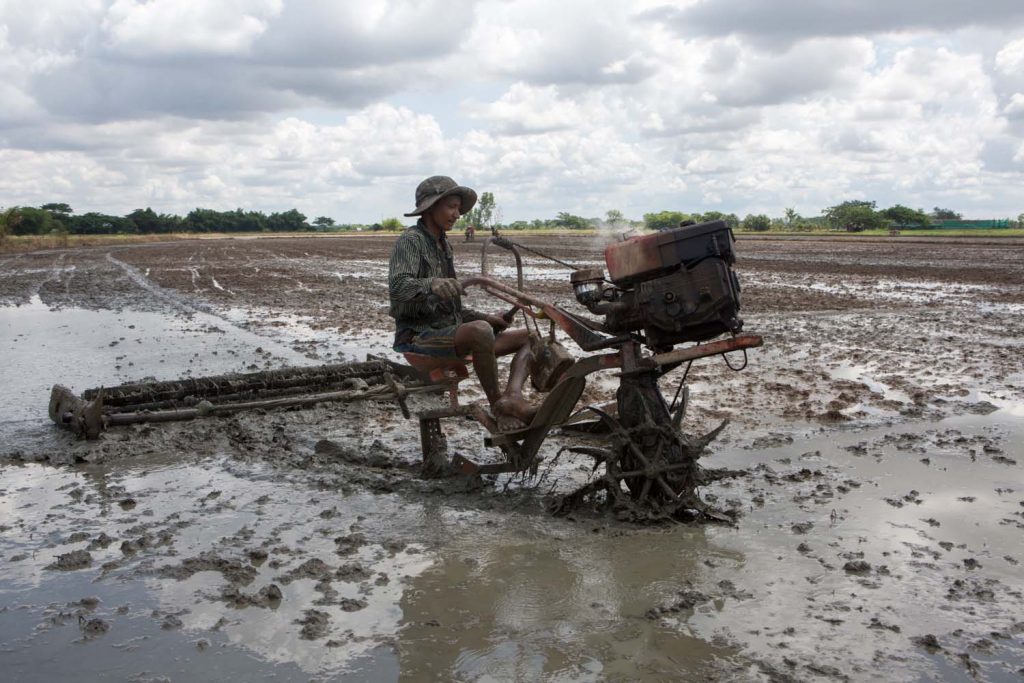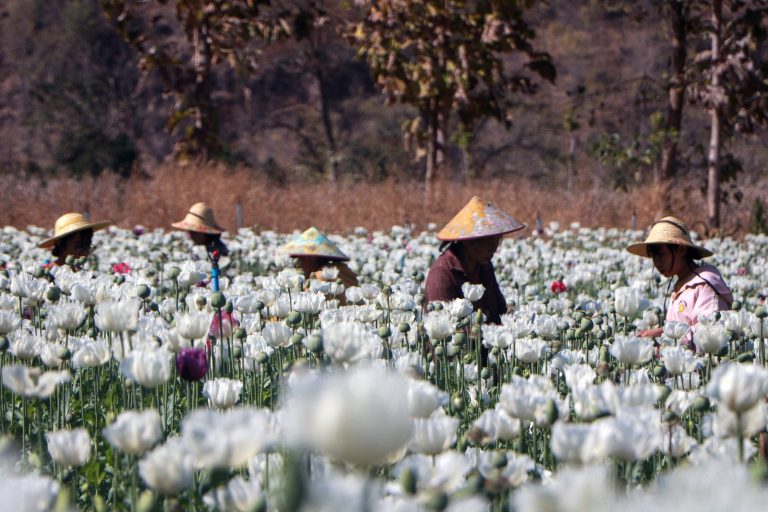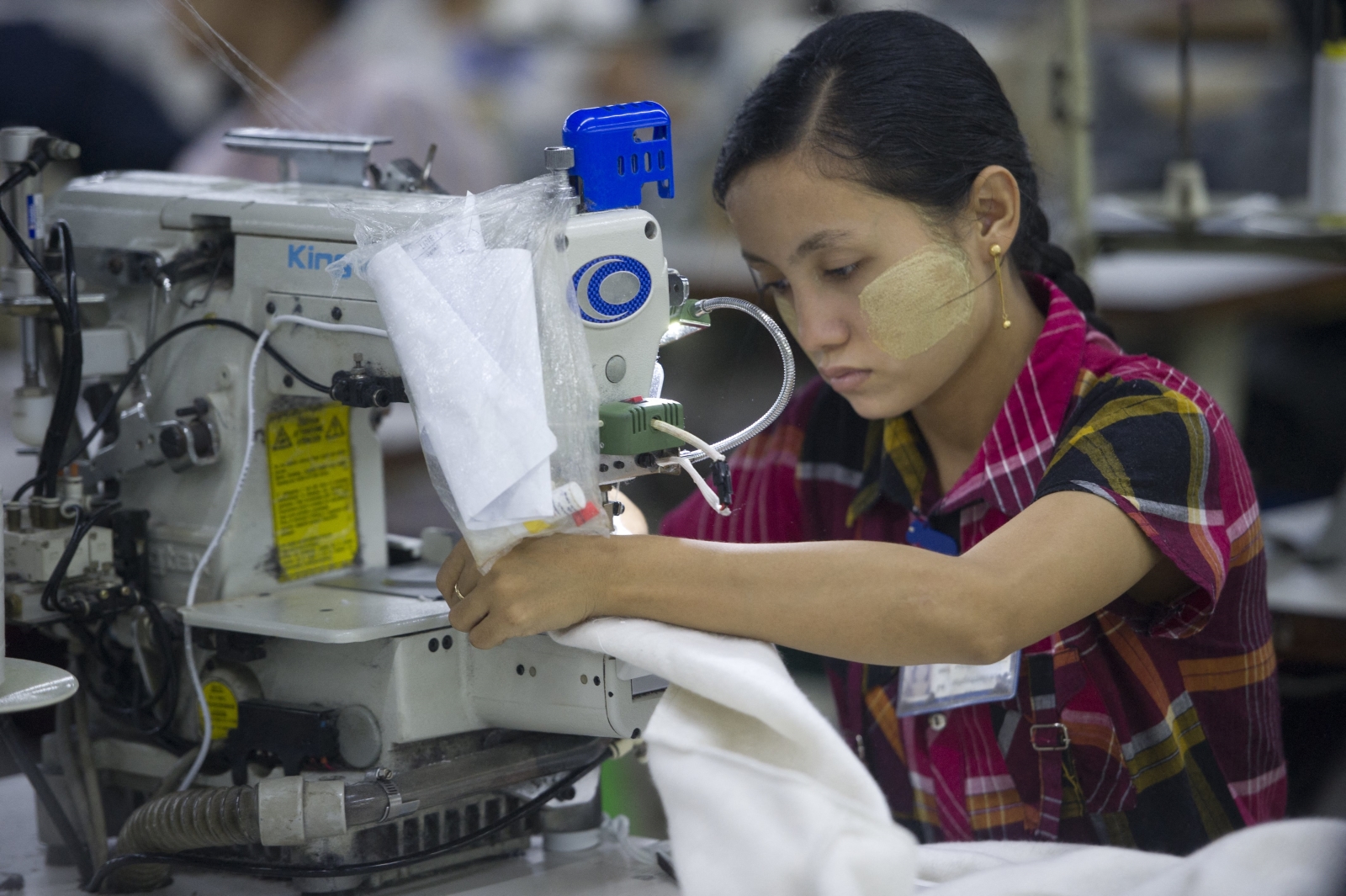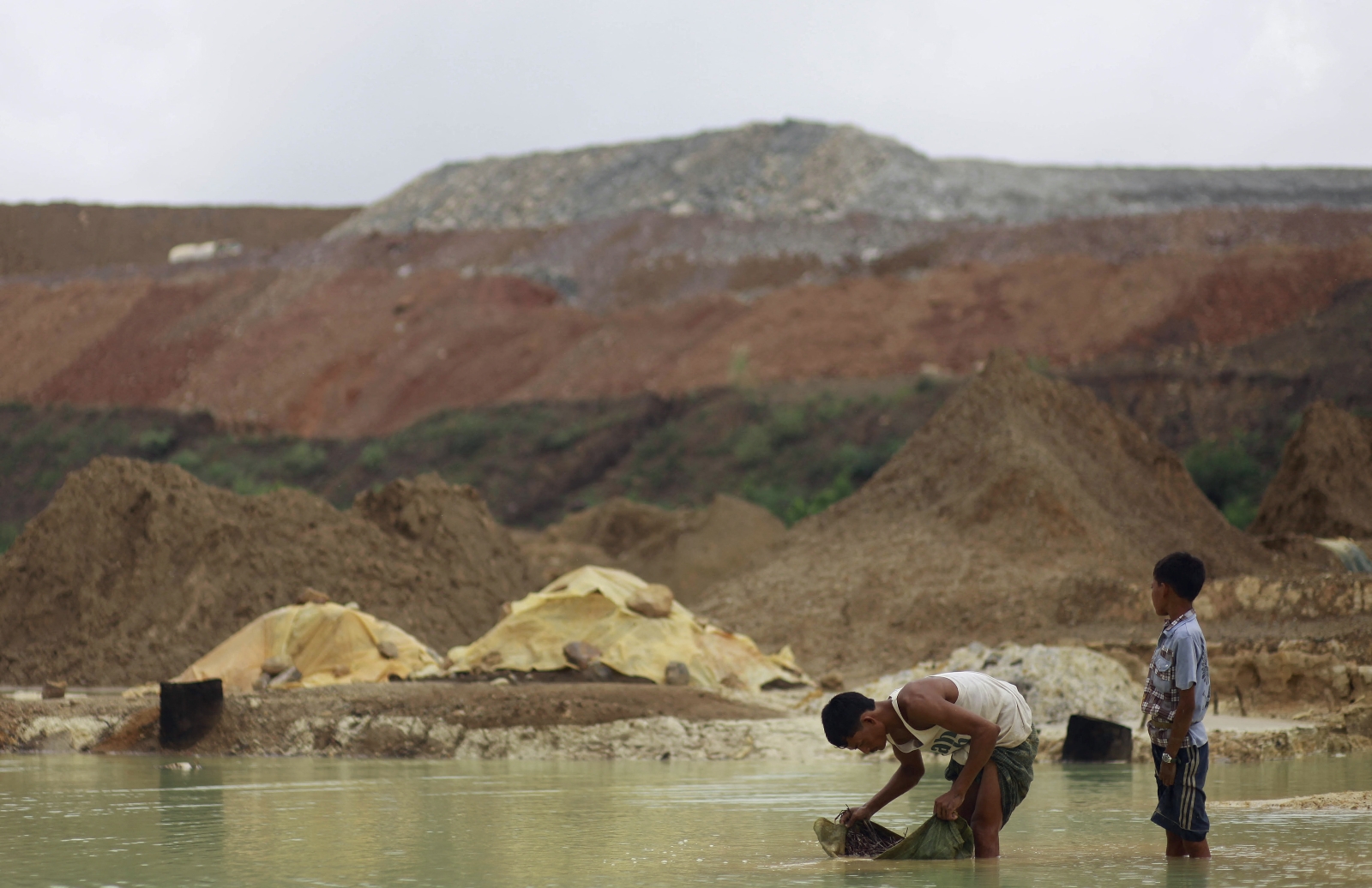COVID-19 does not appear to have had a significant impact on monsoon planting for paddy despite some farmers facing financial difficulties, and the agriculture sector is expected to keep growing amid a slump in other parts of the economy.
By KYAW LIN HTOON | FRONTIER
Myanmar’s most important crop – grown on roughly half of its arable land – appears to have emerged relatively unscathed from the coronavirus pandemic.
When the country’s first COVID-19 cases were reported on March 23, harvesting had begun for the summer rice crop; three months later, as efforts continue to keep the coronavirus under control, planting has begun for the monsoon crop.
Overall, the agriculture sector, which accounts for 22 percent of GDP and 38pc of employment, had been “resilient”, the World Bank said in its June Myanmar Economic Monitor, and is expected to grow by 0.7pc for the year.
This is mostly due to strong production of crops, such as rice, and beans and pulses, with COVID-19 inflicting a much greater impact on export-oriented agriculture sub-sectors, such as livestock, fisheries and fruit production.
A World Bank survey in May found that while agriculture firms were the most likely to have experienced cash-flow shortages and reduced access to credit due to COVID-19, just 6pc of them were forced to close. In contrast, 12pc of manufacturers, 15pc of retail and wholesale businesses and 39pc of service companies shut their doors.
But the impact of the virus remains a threat, says the Myanmar Rice Federation. It has asked the government to take a range of measures to strengthen the sector during the pandemic and beyond, including mitigating the impacts of climate change, particularly flooding, along with increasing financial and technical support.
The government should ensure farmers have greater access to low-interest loans for buying inputs in order to ensure higher yields, the MRF said. It also urged greater flexibility on repayments so that farmers can wait a few months after the harvest, when overseas and domestic demand usually rises, rather than sell their crop at the same time to pay off debts, which pushes prices down.
“We want to work with the government to create a mechanism to [maintain price stability]; the situation requires smart intervention from the government,” said MRF chair U Ye Min Aung.
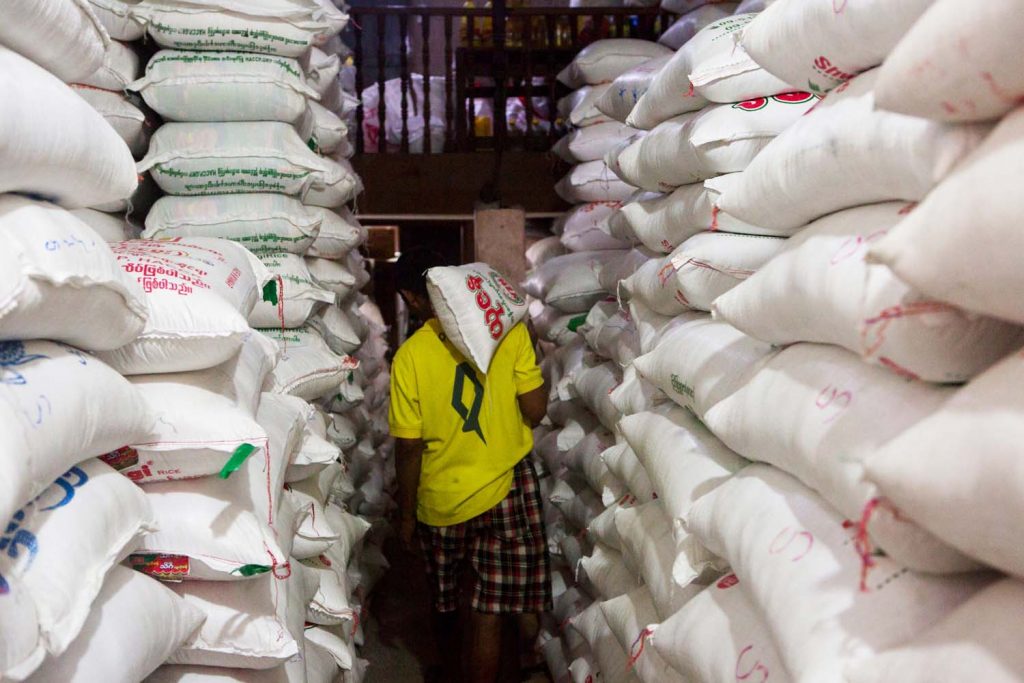
Exports and rice reserves
The government and private sector are confident that there will be no significant drop in production this year. Many paddy farmers have cultivated through the pandemic and rice is continuing to reach domestic and international markets.
Exports for 2019-20 to the end of June stood at $621 million from the sale of more than 2 million tonnes – about $100 million and 400,000 tonnes more than the same time last year.
“I think by the end of this fiscal year, at the end of September, we should be able to export more than 2.5 million tonnes,” said U Min Min, director general of the ministry’s Department of Trade.
But exports did halt briefly as a result of the pandemic. After some panic buying in Yangon’s wholesale markets in March and April, the commerce ministry stopped issuing rice export licences on April 10. Because each licence has a one-time usage, the move essentially blocked all exports.
“In such a situation, we could not allow traders to export as much as they want and we realised we needed to have reserve stocks for an emergency supply,” said Min Min.
In mid-May, the ministry allowed exports to resume but also began a policy for all exporters to sell 10pc of each shipment to the government at a fixed price.
For the first time since 2011, the government was stockpiling rice reserves in case of food emergencies or spiralling prices, perhaps prompted by the pandemic and a wake-up call about the fragility of supply chains.
Invest in Frontier Myanmar’s independent journalism by becoming a member. Sign up here.
Initially, the private sector did not welcome the rice reserve plan because the government was buying at low prices. However, attitudes changed when the government paid for the rice with unusual haste, said Ye Min Aung.
“The government paid the exporters in three banking days; we have never experienced anything like it before in our lives,” he told Frontier.
By late June, the reserve had reached 80pc of its 50,000-tonne target, and the commerce ministry agreed to reduce its quota to 5pc from July 1 during a meeting with the MRF on June 26.
The MRF also suggested more dedicated warehouses be made available. This year the government needed to rely on privately-owned warehouses, because most state-owned warehouses are in residential areas and are unsuitable for receiving large amounts of rice.
Overall, Myanmar had maintained a smooth supply chain that avoided shortages and kept prices stable, said MRF executive member U Myo Thuya Aye, who added that overseas buyers are submitting offers again.
On June 13, Myanmar won a tender to supply the Philippines with 75,000 tonnes of rice this year, and the ministry said Malaysia and Indonesia have also expressed interest in export deals.
Out in the fields
While production might remain high, at the micro level many farming households are still feeling the strain.
Longstanding problems, such as inefficient growing techniques and lack of access to affordable credit, are combining with COVID-19 factors – including reduced income from work and remittances – to create hardship.
Many rely on microfinance institutions, which lend at a maximum of 28pc a year, so they have the cash to buy inputs like fertiliser and seeds, and to pay casual workers.
This year, though, microfinance institutions are facing their own liquidity crunch. In an effort to reduce pressure on borrowers, the regulator for the microfinance sector, the Financial Regulatory Department, announced the suspension of loan collections by microfinance companies from April 5 to May 15, and loan repayments had to be rescheduled. FRD also limited deposit and lending services to company premises, effectively curtailing new lending during this period.
Microfinance companies have resumed loan collections and new lending. But as Frontier reported in June, with less cash coming in they’ve had to “ration” their loans and offer fewer or in smaller amounts.
Read more: COVID-19 pushes rural Myanmar towards moneylenders
Even before COVID-19, microfinance institutions lacked the capital to meet demand for credit, says Mr Curtis Slover, the head of the financial inclusion and private sector programme at the Livelihoods and Food Security Fund (LIFT), which works with 75pc of the sector by asset size.
LIFT is anticipating a $180 million to $200 million liquidity shortfall among the microfinance companies it works with because of COVID-19 and plans to bring more than $50 million into the country for lenders, but Slover doesn’t expect cash flows in the sector to return to normal until September or October.
“Before COVID-19 we were hoping to be able to help microfinance companies issue larger loans this year,” he said. “But given what’s happened, this ‘top up’ is designed to try and make sure that borrowers are able to get a loan of the same size … there’s just not enough money in the sector to meet demand.”
Despite reduced incomes and difficulties getting credit, Slover said it seemed that many farmers were still planning to cultivate a similar amount of land this monsoon.
“Agriculture is considered a necessity for households so if they have a limited amount of money, they’re going to cut back on things that aren’t considered necessities,” he said.
However, this could mean reduced spending on things like health or education that may have other negative consequences. “That’s where the worry is – not necessarily that agriculture will be affected,” he said.
The state-owned Myanmar Agricultural Development Bank is another important source of credit for farmers and in a move they have widely welcomed has cut its interest rates from 8pc to 7pc this year.
However, it only lends K150,000 an acre – less than the typical cost of cultivation – on a maximum of 10 acres per person.
For a farmer like U Aye Htay, 63, who grows paddy on his 60-acre farm in Thida Myaing ward of Yangon Region’s southeastern Kyauktan Township, the loan will only be enough to cover about 7 acres.
He’ll have to find the rest of the investment from other sources, but that will be more difficult this year because he can’t rely on his two children: both work in a factory in the Thilawa Economic Zone and have had to take pay cuts due to COVID-19.
That means he’ll need to borrow anywhere from K5 million to K10 million from informal lenders. “When we borrow from other sources in the community, we have to pay interest of at least 8pc [a month],” he told Frontier.
Aye Htay said the government could help farmers by increasing the loan amounts that MADB distributes to at least K200,000 or K250,000 an acre.
U Kyaw Thein, 58, who farms 35 acres of paddy at Hle Seik village in Bago Region’s Bago Township, says farmers in the area were not greatly affected by COVID-19, but face the usual difficulties with inputs, production and logistics.
“Whether during a pandemic or in normal times, what farmers always need is more types of machinery, more capital, and advanced technology,” said Kyaw Thein, who has a small rice mill.
He said some farmers cling to traditional ways of farming and are unable to embrace modern technology.
“We try to encourage them to change, and some of them have done so, but we need to educate farmers throughout the country,” he said, adding that few paddy growers understand safe storage systems and modern production technology.
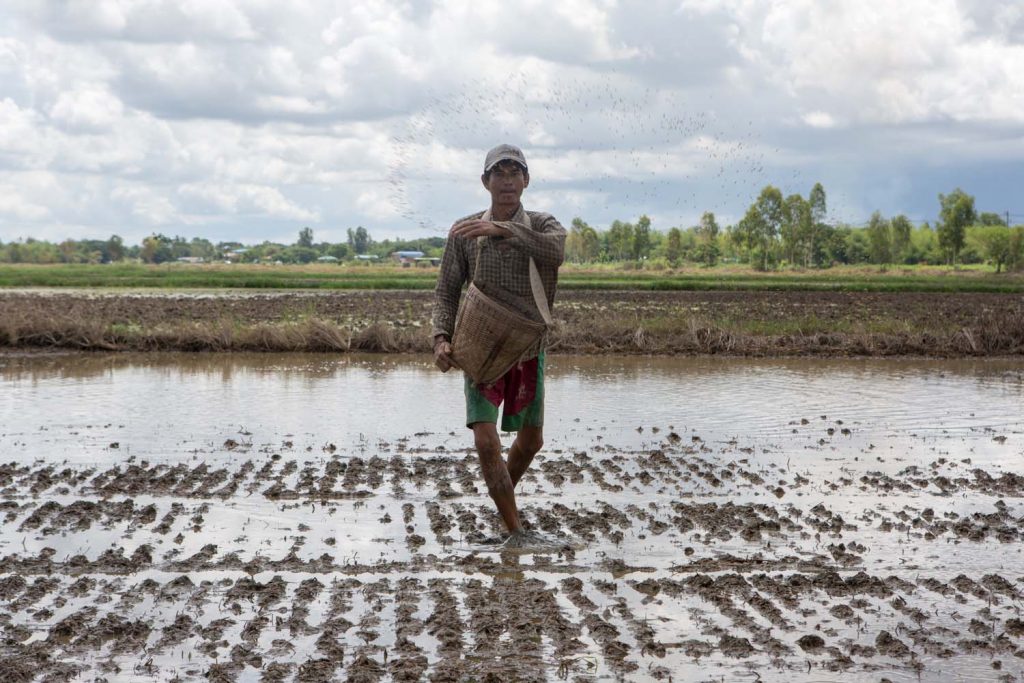
A mooted future for farming
The government and the MRF have also embarked on separate plans to introduce contract farming on paddy land – mostly in the Ayeyarwady Delta – this monsoon season.
The Ministry of Agriculture, Livestock and Irrigation plans to contract farm 200,000 acres for seed production, while the MRF also plans to use 200,000 acres for grain as well as seed. No contracts have been signed yet and information about the schemes is sparse.
Contract farming usually involves a company specifying the quantity and quality of a particular product for the farmer to deliver at a certain date at an agreed price. Sometimes the company pays for the seedlings and agrochemicals or other input costs, which lessens the risk for farmers.
But the minority of paddy farmers who are familiar with the practice have often had negative experiences.
Farmers and organisations such as the Agriculture and Farmer Federation of Myanmar and the Myanmar branch of the International Union of Food, Agricultural, Hotel, Restaurant, Catering, Tobacco and Allied Workers’ Associations, told Frontier they were concerned at the lack of information about the new schemes.
“Myanmar still needs to carry out agricultural reform and policy reform, and farmers also lack good production insurance schemes, and if we launch contract farming it will be risky for farmers,” said U Zarni Thway, chairperson from the AFFM.
He urged the government and the private sector not to rush into contract farming, which he has studied in other countries. He would like to explain how it could be made into a success in a meeting with the government, companies, and farmers’ representatives, he added.
Invest in Frontier Myanmar’s independent journalism by becoming a member. Sign up here.
His concerns were echoed by Ko Nyan Aung, from the IUF Myanmar, who said that without a strong policy, the contract farms would follow the way of big Thai agribusiness conglomerate Charoen Pokphand’s maize farms in Shan State.
Those yields were good at the start of the initiative in 2012-13, he said, but then insects began damaging the crops. According to the contracts, the farmers had to use the company’s pesticides and chemical fertiliser, which eventually depleted the soil of nutrients, he said, and prevented them from returning to paddy production.
MRF chair Ye Min Aung said it was understandable that farmers and activists should oppose the schemes when little is known about them, and many remember the disastrous contract farming programmes introduced by the military government.
“Of course, they should be worried,” he said. “But the new model for contract farming is better because it is based on our past experience of failure and years of preparation.”
Contract farming would ensure that enough high-quality seed was available to farmers each season and at a fair price, said U Myo Tin Tun, the agriculture ministry’s deputy permanent secretary, on the government’s project.
MRF executive committee member U Myo Thura Aye said concern about contract farming was misplaced and said it could be beneficial for both buyers and growers, particularly for seed production.
“We will fix the prices with a strong commitment before we start growing,” he said, adding that the programme would only be implemented on a fraction of the 14 million acres on which paddy is grown throughout the country.
The MRF has been pushing for contract farming for years. In 2017, it urged the government to draft standard operating procedures and guidelines for contract farming that were officially issued on January 30, 2020, under the 2013 Law of Protection of the Farmer Rights and Enhancement of their Benefits.
Ye Min Aung said this means farmers would now have legal protection.
“The contract farming schemes that failed in the past were signed by only two parties – the company and the farmers – but the new contracts will be issued through a tripartite mechanism that involves the government.”
“If the farmers feel they are being cheated by the companies or there is a bad environmental impact, in these more transparent times, the farmers can speak to CSOs and independent media.”
– Additional reporting by Thomas Kean


